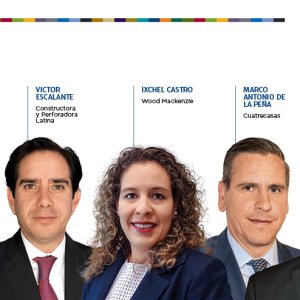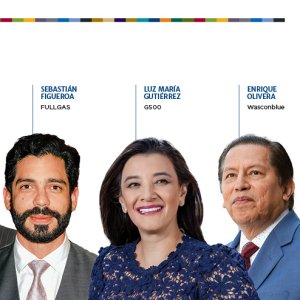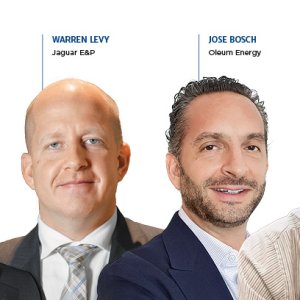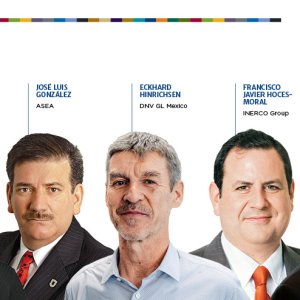
Highlights of The Mexico Oil & Gas Summit 2014
From left: Jose Pablo Rinkenbach, Cesar Vera and Ernesto Marcos Giacoman
Jose Pablo Rinkenbach, Managing Partner of Ainda Consultores chaired a panel with Ernesto Marcos Giacoman, President of AMESPAC, and Cesar Vera Mendez, Area Manager at Nabors Industries, discussing the key factors that will contribute to the success of the private oil and gas companies following the sweeping reforms to the industry.
Rinkenbach opened up the panel with a discussion surrounding the state of the private industry as it stands today in Mexico, presenting facts and figures elucidating the extent of investment. Rinkenbach explained that there are almost 1000 private companies operating within the National Energy sector, 370 of which are dedicated to the well services segment, which makes up 50-60% of the industry’s CAPEX. 20 services lines currently support well construction, and 20 national companies operate within this area. The focus of the remainder of the panel discussion covered what needs to be done to grow the sector and support new companies starting up, particularly national ones.
Cesar Vera Mendez discussed the role of PEMEX in supporting the development of the private sector, saying that the historic monopoly has played the major role in establishing the industry and will continue to be a crucial client. Private companies need to be a part of PEMEX’s procurement projects and therefore the reform and opening of PEMEX practices is key. Vera also purported that going forward what exactly defines a national company needs to be established. “Talking about national content we need to look averages. It is easy to define when you are talking about tangible products, but what about when we are talking about services for example. Corporate structure is also relevant; if a foreign investor decides to start a company by issuing bonds or shares to a local investor, then that can be classified as local content,” Vera said.
Ernesto Marcos Giacoman asserted that what Mexico really needs is a Cemex for oil. In the meantime the Mexican companies that work for PEMEX must increase standards and internationalize so that they can become global actors. Marcos added that Mexico has begun to generate a national database for the companies that provide specific types of services, which the country has not had until now. This will help the financial sector, which currently has no idea of what the industry actually looks like. All parties agreed that the private sector should not wait for a 3rd party to provide guidance on how to improve human capital but rather start working with the educational and public sector to create the right conditions to support sector growth immediately.
Luis Ramos Martínez, Acting Subdirector for Planning and Evaluation of PEMEX Exploration & Production spoke about PEMEX’s ongoing strategy to continue being the leading producer of oil in Mexico. Ramos explained that the main PEMEX strategy is to align itself to work and reach several objectives and that a business plan is being defined for the requirements in terms of expenditure and growth. “We believe that the reform is going to allow for better management, better decision-making processes and more financial efficiency. We need to generate a culture directed to results,” said Ramos.
One of the key focal points, and one that Ramos spoke of at length, was the company’s strong focus on human capital development. He explained that there will be a different dynamism as PEMEX tries to improve its offerings as an employer. The payment model is going to be different and will be adjusted to international best practices in order to retain and attract the right people. “We are going to try and generate rotation schemes that will encourage knowledge regeneration. We are going to work on payback schemes that are on a par with international practices,” said Ramos. There will be higher salaries for expert positions, as well as long-term development strategies. When asked by the audience how PEMEX planned to recapture lost talent Ramos also confirmed that they are working with retired engineers to provide coaching services. Ramos also explained PEMEX’s goal to prepare for non-conventional sites in deep waters, adding that the challenge ahead is to monetize the current hydrocarbons base.
In the first of two presentations on how to address mature fields, Miguel Angel Lozada, PEMEX’s Administrator for Cantarell said that the major challenge in mature fields was to increase the recovery factor in the long-term. “We need to rejuvenate these mature fields. We want to accurately project the states of the fields, project when we need to apply enhanced recovery methods. This challenge involves IT, technology and financing,” he outlined.
He also gave some statistics as to how Mexico’s production will fare compared to the rest of the world. Mexico’s 1P reserves will allow it to produce for 10.6 years at current global average production rates, as opposed to over a century of production for the world in total. For 2P reserves, there are fields that will see their reserves exhausted in 20 years, although others may last up to 60 years, making their particular exploitation of great interest. For example, Akal has a remnant reserve of 2.3 billion barrels. “The challenge lies in that the recovery factor in PEMEX’s fields reaches 35%, but our forecasts shows this rate could jump by 10% once the right technology and applications are in place,” said Lozada.
However, he added that the cost of operations can almost double if enhanced recovery factors take the recovery factor from 35% to almost 50%. When this goes over 50%, costs increase significantly again, leading Lozada to caution that thought would have to be given to Mexico’s tax regime and PEMEX’s investment allocation to match these rises in cost.
Lozada explained that since the boom in IT development for horizontal well drilling and multi-stage well drilling in the 1990s, Mexico has seen a regular increase in production from the application of these techniques. He calls for the same logic to be applied to newer technologies such as horizontal wells. “Mexico has stressed the importance of increasing production from existing wells. The enhanced recovery methods used led to an increase in production from declining wells. Artificial lift systems, water injection, gas injection were all used to illustrate the proper management of such wells,” added Lozada.
Giving specific examples of fields, he pointed out that Cinco Presidentes began declining in 2001. But 3D seismic data elucidated new resources that had not been drilled and horizontal wells were used to recover them. In the Northeast Marine Region, Ek-Balam produced 6,000 bpd but this now stands at more than 60,000 bpd, in large part due to the use of horizontals wells. He added that sand control technology will be implemented and horizontal drilling would be maintained until Ek-Balam reached 100,000 bpd.
Edgar Rangel, Commissioner of the National Hydrocarbons Commission (CNH), took over to explain that IOR and EOR would help Mexico be successful in its brownfield projects and in mature fields, as these methods aim to extract up to the last drop of available. However, the way in which they are used must depend on the conditions of each field involved. “We have different strategies available to use IOR and EOR that can be combined to get better displacement and retrieve the hardest to reach oil by getting to the furthest corners of a well and use chemicals to extract it,” he said.
IOR methods involve any post-primary recovery methods and EOR, is a tertiary recovery technique which typically recovers remanent oil by injecting chemicals such as surfactant polymers. Rangel confirmed that the wise combination of IOR and EOR would significantly improve the recovery factor, while not wasting resources like water and gas. “Mexico has a lot of potential for the use of all these technologies. Pilot tests will prove the viability of IOR and EOR and then lead their utilization to become massive,” he said. As part of PEMEX’s catalog, the country has a commitment to meet outputs of 3 billion barrels a day and then 3.5 billion barrels. He concluded that IOR and EOR will determine how efficient authorities can be in reaching that production level.
From left, Bud McGuire, Ernesto Iniesta, and Juan Trebino”
Bud McGuire, Principal and Co-founder of Alpha Petroleum Services, moderated the panel entitled ‘Blueprint for Mexico’s Deepwater Future.’ He pointed out that the challenge to deepwater development is not technology, but licensing terms that are competitive with other investment opportunities in other parts of the world. “A contract is not good unless it is good for both parties. This approach will attract the technology that Mexico needs,” McGuire said and insisted that capital follows projects that yield good returns. He stressed that deepwater developments require a tremendous amount of capital. “These are mega projects of US$1 billion or more. Projects require capital and very long planning, as mistakes are really expensive.” McGuire also mentioned qualified personnel as a crucial element for deepwater that Mexico does not have. Because foreign companies will bring their talent, McGuire suggests native companies such as PEMEX should recruit from the global market.
Commenting on how Mexico can push its deepwater segment, Juan Trebino, Vice President and Partner at Strategy&, said Mexico is competing not only with international players, but also with different types of hydrocarbons that the market wants to develop. In this sense and before technological discussions, Trebino says Mexico has to ensure an environment without legal or environmental restrictions so that national champions and international participants can compete and attract capital. “Deepwater developments are enormous projects with very long life cycles that force us to create contractual frameworks. It is important for parties asking for loans to be able to use the oil molecule as hedging.”
As for technology, Trebino expressed the importance of creating technology centers in Mexico. “There are four deepwater technology poles in the world: the Gulf of Mexico, Brazil, Singapore, and the North Sea. Mexico should join these poles through its Gulf of Mexico operations. This is not about simply creating specific capacities, but to develop the entire deepwater value chain, from subsea well completions to transportation tankers.”
Panelist Ernesto Iniesta, FMC Technologies’ Commercial Director of the Subsea Division Latin America, said drilling in deepwater is mostly intended to explore and estimate reserves. When a reserve is found, he tells, an exploratory well is drilled. But in deepwater, three or more exploratory wells have to be drilled. “Mexico has been exploring deepwater reserves for 14 years. The country began with 400m and now it almost has 3,000m in Perdido.” For him, the challenge is to bring the fluids up to the surface. “Chevron managed to drill to depths of 2,400-2,900m. It took nine years to develop the technology to bring oil to the surface in Perdido. We need to improve efficiency in this area. Given the deepwater conditions in the Gulf of Mexico, there is not a system that can meet Mexico’s deepwater production targets,” Iniesta said. He added that the country will face companies that have a 30 year technological advantage over PEMEX. Therefore Mexico has to develop the technological and human resources to reach the heights of other international players. “The northern area of Perdido is very complex and production will require at least six players.”
In a panel seeking to answer major questions about the future of unconventional resources in Mexico, Arindam Bhattacharya, the Director General of Schlumberger Mexico, sat down with Vinicio Suro Pérez, Director General of IMP, and Rogelio Montemayor Seguy, the President of the Mining and Petroleum Cluster of Coahuila.
Bhattacharya began by outlining differences between the US and Mexico. “The US has 60 billion barrels of oil equivalent in unconventional resources and 32,000 wells have already been drilled to tap into these reserves. Can Mexico match that level of activity?” he asked. He divided the challenges associated with unconventional resources into above and below ground. Above ground, efficiency must be maximized in unconventional operations. To do so, logistics, infrastructure, resource management (water, sand), and community relations are all essential.
For subsurface activity, a lot of wells are vertically drilled and new scientific advances have not yet been applied in the shale assets of the Mexican oil and gas industry. Schlumberger has sought to help science catch up, by investing a lot in technology and shale exploration. “Science-guided exploration will help find sweet spots, optimize the completion design to ensure we only complete where we can return our investment. We have to maximize production while minimizing resource usage. This is why a complete unconventional field development plan is needed. This would involve identifying specific drilling techniques and optimum circulation techniques on a well-by-well basis to help ensure resource optimization,” said Bhattacharya. He added that doing so could improve resource utilization between 20 and 50% on different wells as well as improving efficiency by focusing on sweet spots only. He added that the successful development of shale resources would depend on collaboration between many stakeholders, including education, security, social, fiscal, logistics, resource management and infrastructure.














